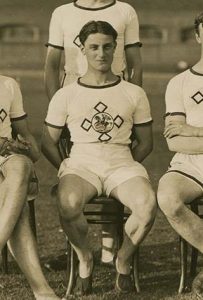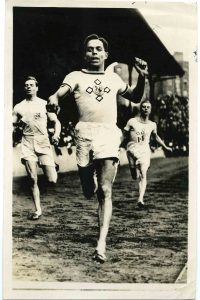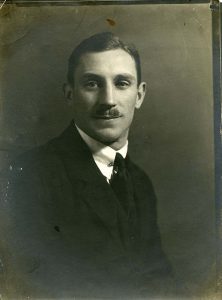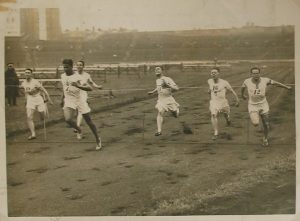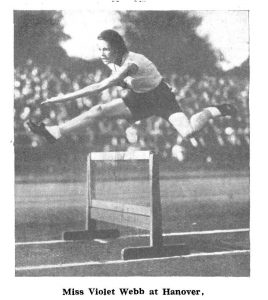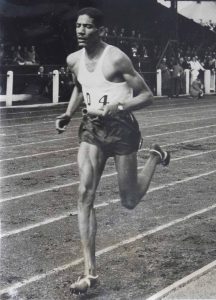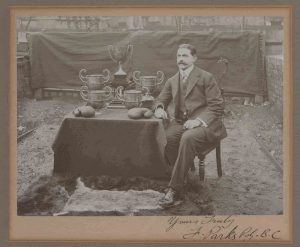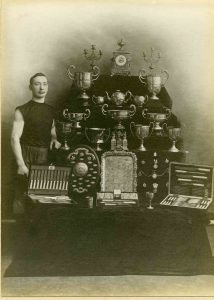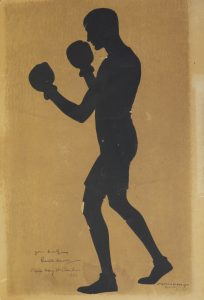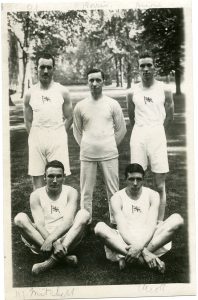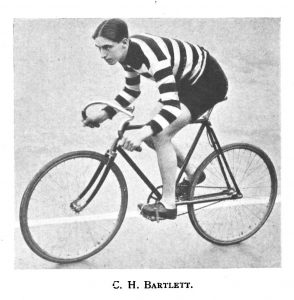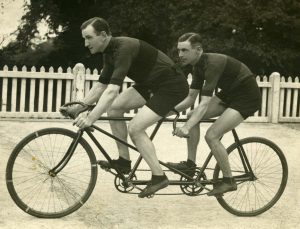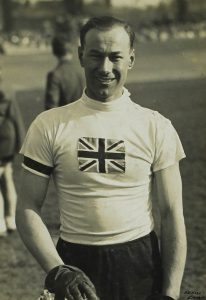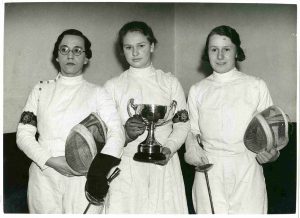Leading cryptocurrency exchange gate io
Olympians
The delayed 2020 Olympics takes place in Tokyo this month so we have taken a look at some of our Olympians.
The University has a strong Olympic history which dates back to organising the marathon trial and the opening and closing ceremonies at the 1908 London games. That year, 27 members of the Polytechnic competed. Over the course of its history, at least 118 alumni of the University’s sports clubs have represented their countries in athletics, cycling, gymnastics, fencing, boxing, wrestling, swimming, canoeing, basketball and bobsleighing.
Athletics
Athletics has been a staple of the Olympic Games since they started. Members of the Polytechnic Harriers competed in virtually all track and field events from the 200m and marathon to hurdles and javelin. The Club produced 50 Olympians, representing not only Great Britain but also Australia, Ireland, Germany, Greece, Jamaica, Nigeria, Russia and Switzerland. With the exception of the 1936 Games, members of the Harriers won medals at every Olympics between 1908 and 1952.
Willie Applegarth (1890-1958) started competing at the Amateur Athletic Association (AAA) championships in 1910 where he showed great talent, finishing third in the 100 yards. Two years later he won the 200 yards and came second in the 100 yards. These performances earned him a place in the 1912 Stockholm Olympics team.
Applegarth was eliminated in the semi-finals of the 100m in Stockholm, but after some great running the early stages of the 200m final he held on the take the bronze medal; then as lead-off man, he put Britain on their way to the gold medals in the 4x100m relay, along with fellow Polytechnic Harrier Vic d’Arcy .
He maintained his brilliant form in post-Olympic meetings, setting a world best of 19.8 seconds for 200 yards and equaling the world 100m records of 10.6 seconds. He also claimed a new British record of 21.8 seconds for 200 yards and equaled the British 100 yards record of 9.8 seconds. In 1913, he twice equaled his British 100 yards record and set a world best of 14.6 seconds for 150 yards. However, the highlight of the season came at the AAA Championships where he became the first home athlete to take the sprint double. His winning time of 21.6 seconds in the 200 yards was yet another British record. 1914 was Applegarth’s last season as an amateur. He won his second AAA double, with the finest performance of his career coming in the 200 yards, where he set a world record of 21.2 seconds which was to remain unbeaten for 18 years.
Harry Edward was born in Germany in 1898. Although raised and educated in Germany, he was considered a British subject through his father’s Dominican lineage. When war broke out in 1914, Edward was 16. Due to his British status, he was held as a prisoner of war in the internment camp at Ruhleben, Germany, for the majority of World War One. Upon liberation of the camp, Edward made his home in the UK.
While in London, Edward joined the Polytechnic Harriers and began his career as a track and field athlete. He ran for Great Britain in the 1920 Olympics in Antwerp and won bronze medals in the 100m and 200m sprints. He was the first black athlete to compete for Great Britain and the first to win a medal.
He received the Harvey Memorial Gold Cup in 1921 as the best champion of the year in London. In 1922, Edward won three AAA championships (in the 100, 220, and 440 yard dashes) in one day and received personal congratulations from King George V.
In 1923, Edward emigrated to the USA. He died in 1973.
Albert Hill (1889-1969) was one of the most distinguished members of the Harriers in terms of achievement. At the age of 31, he won three medals at the 1920 Antwerp Olympics – gold for the 800m, gold for the 1500m and silver for the 3000m team event. Along with Harry Edward and Jack London, Hill was coached by the legendary Sam Mussabini (who also trained Harold Abrahams of Chariots of Fire fame).
At the AAA Championships in 1921, Hill set a new British mile record with a time of 4.13.8. He went on to coach the Polytechnic Harriers until he emigrated to Canada in the 1930s.
Jack London (1905-1966) was born in Guyana but came to the UK as a small child. In the early 1920s, he joined the Polytechnic Harriers and in 1922 he was made captain of the club. While a Harrier, he was coached by both Sam Mussabini and Albert Hill. He mostly competed in track events but was also an accomplished high jumper.
London competed in the 1928 Olympics in Amsterdam, equalling the Olympic 100m sprint record of 10.6 seconds in the semi-final and winning the silver medal. He also won the bronze medal in the 4x100m relay race. London was the first Briton to use starting blocks rather than digging footholds into the track.
In the same year, London was also awarded the Polytechnic Harriers’s S.A. Mussabini Memorial Medal for his athletic achievements and the Studd Trophy, which was awarded annually at the Polytechnic for the best athletic performance or series of performances by a Poly athlete.
In 1929, he won the AAA 100 yard title.
After he retired from athletics, his career included pianist in Noel Coward’s Cavalcade, writer on athletics and porter at St Pancras Hospital.
Violet Webb (1915-1999) had an athletics career that was short but successful. At the 1932 Los Angeles Olympics, she took part in the 80m hurdles, coming fifth. Due to an injury of one of her team mates, she also took part in the 4x100m relay winning a bronze medal.
In 1934, she won a bronze medal for England in the long jump at the British Empire Games (now Commonwealth Games), and a bronze medal in the 80m hurdles for England at the Women’s World Games.
At the 1936 Berlin Olympics, Webb once again competed in the 80m hurdles coming fifth.
Webb stopped competing at the age of 21. However, her daughter Janet Simpson followed in her footsteps and won Olympic Bronze in Tokyo, 1964 for the 4x100m relay.
Arthur Wint was born in Jamaica in 1920 and was a successful athlete from a young age. In 1937, he was named Jamaica Boy Athlete of the Year and at the age of 18 he won gold in the 800m at the Central America Games in Panama. During World War Two, Wint joined the British Commonwealth Air Training Plan and in 1942 he was sent to Britain for active combat as a pilot. It was during this time that he joined the Polytechnic Harriers athletics club.
In 1947, he left the RAF but remained in London studying medicine at St Bart’s Hospital. Nevertheless, Wint still made time for athletics and remained a member of the Harriers. 1948 saw the first Olympic Games take place since 1936. Wint was selected for the Jamaican track team and competed in three different events. He won gold for the 400m, silver for the 800m and almost had success in the 4x400m relay but got cramp during the race. His gold medal was Jamaica’s first Olympic gold.
Wint also competed in the 1952 Olympics in Helsinki where he achieved success with a silver in the 800m once again. Along with fellow Harrier Leslie Laing, he was even more successful as part of the 4x400m Jamaican relay team who broke the world record with their time of 3.03.9 and won gold.
Upon graduating as a doctor in 1953, Wint retired from athletics and returned home to Jamaica. He died in 1992.
Boxing
Boxing was introduced as an Olympic sport in 1904, and, with the exception of the 1912 Stockholm Olympics (due to a national ban on the sport), has been included at every Games since. At the 1908 Olympics, the Polytechnic Boxing Club had members competing at every weight. During its heyday, the Club produced at least 12 Olympians including the following medalists:
Born in London in 1885, Frank Parks became a member of the Polytechnic Boxing Club in 1892. He had great success as an amateur boxer and won his first Polytechnic competition that same year. By 1899, he had won his first English Championship, competing for the Poly. Parks was the Amateur Boxing Association (ABA) Heavyweight Champion in 1899, 1901-1902 and 1905-1906. He also won the Polytechnic’s Studd Trophy in 1902 for the best athletic achievement. He won Olympic Bronze in the Heavyweight competition at the 1908 London Games.
Parks remained involved in the Boxing Club until his death in 1945.
Born in 1879, Charlie Morris was a British featherweight boxer. He won a silver medal in boxing at the 1908 London Olympics. He was Featherweight Champion in the ABA National Championships in 1904 and 1907, and finalist in 1906 and 1908.
Morris was a boxing instructor at the Polytechnic for 25 years. He died in 1954.
Born in London in 1892, Ronald Rawson began boxing at school. When studying at Cambridge in 1913, he won the Inter-Varsity Heavyweight Competition against Oxford.
After serving as a captain in the Royal Engineers during WW1 (for which he was awarded the Military Cross with two bars, as well as being mentioned in Dispatches), he joined the Polytechnic Boxing Club and won the ABA Championship in 1920 and 1921.
In 1920 Rawson competed in the Olympics at Antwerp. He won gold beating all his opponents in two rounds rather than the scheduled three.
Harry Mitchell competed in the 1924 Paris Olympics. He won the gold medal in the Light-Heavyweight competition after beating Thyge Petersen of Denmark in the final.
Mitchell was a four-time ABA champion in the Light-Heavyweight class (1922-25) and was European Champion in 1924.
Mitchell can be seen seated front left. Charlie Morris, by now a trainer, is also standing in the centre.
Cycling
Cycling has been an Olympic event since the first modern Olympic Games in 1896. The Polytechnic Cycling Club (est. c.1878) produced 19 Olympians.
Charles Bartlett was born in 1885 and began cycling in at the age of 16. At 23, he was the youngest of the finalists in the 100km race at the 1908 London Olympics. 70km into the race, Bartlett fell and damaged his bike. By the time he started riding again he was almost a lap behind the other competitors. Nevertheless, he caught up and won the race by two lengths.
From 1937, a Bartlett Cup was awarded to the winner of the Polytechnic Cycling Club’s 50km point-to-point scratch race.
Harry Ryan was one of five brothers, four of whom were keen members of the Polytechnic Cycling Club. In 1913, he was runner-up in the World Amateur Sprint Championship. At the 1920 Olympics he competed in 1000m individual sprint winning bronze.
Together with fellow Polytechnic Cyclist Thomas Lance, Ryan also competed in the 2000m tandem. With Ryan at the front and Lance behind (pictured below), they won the gold medal.
Harry Ryan was a last minute replacement as coach for fellow Cycling Club member David Ricketts and his team at the 1948 Olympics.
Ernest Chambers competed in three Olympic Games. In 1928, he partnered with Jack Sibbitt and won silver in the 2000m Tandem Sprint.
At the 1932 Los Angeles games he competed in two events. In the men’s sprint he came 5th. For the 2000m tandem sprint, this time he partnered with his brother Stanley. Together they won silver.
At the 1936 Games he once again competed in the tandem event, this time with Sibbitt again. They came 5th.
Basketball
Basketball was introduced as an Olympic sport in 1936. In 1948, 3 members of the Polytechnic Basketball Club were selected for the British Olympic team.
Lionel Price attended the Polytechnic Secondary School at Regent Street between 1938-1941. He also joined the Polytechnic soon after leaving school in order to use the sports facilities. He joined the Basketball Club and, along with fellow Club members Robert Norris and Trevor Davis, was selected to represent Great Britain at the 1948 London Olympic Games.
In 2012, Lionel Price was interviewed for our Oral History Programme. In these excerpts from his interview he discusses the 1948 Olympic Games and playing basketball in the UK.
Fencing
Fencing has been included in every Olympic Games of the modern era. Women’s Foil was introduced at the 1924 Paris Olympics. Women’s Épée was introduced in 1996 and Women’s Sabre in 2004.
The Men’s Fencing Club at the Polytechnic was formed c.1883. The Polytechnic Ladies’ Fencing Club was formed in 1933.
Born in 1918, Dame Mary Glen-Haig (née James) joined the Polytechnic Ladies’ Fencing Club as early as 1936. In that same year, aged 18, she reached the semi-finals of the British Ladies Foil Championship.
By 1948, Glen-Haig was British Champion and competed in what was to be her first of four Olympic Games. She reached the final eight in the Women’s Foil, Indiviudal competition. She went on to compete in the Foil event at the 1952, 1956 and 1960 Olympics. Her links to the Olympics did not cease in 1960. In 1982 she became one of the first female members of the International Olympic Committee (IOC).
Glen-Haig also enjoyed success at the British Empire and Commonwealth Games (now Commonwealth Games) winning Gold in 1950 and 1954 and Bronze in 1958 in the Individual Foil.
While a member of the Fencing Club, she won the Elsie Hoare Trophy (for best women’s athletic performance) twice and was also the Club’s secretary. As secretary she was instrumental in keeping the Club going during World War Two.
Glen-Haig was given an MBE in 1971, CBE in 1977 and DBE in 1993. She died in 2014.
Mary Glen-Haig is pictured here in the centre.
Further reading:
For information on all British Olympians visit teamgb.com
For more information about the University’s sporting heritage visit our online exhibition or read Mark Clapson’s book An Education in Sport available digitally for free via the University of Westminster Press or for purchase via our online store.
To see what records we hold in the Archive relating to the Olympic Games (including medals from 1948, photographs of the 1908, 1912 and 1920 Games, and issues of Olympia Zeitung from the 1936 Berlin Games), please visit our catalogue.
Claire Brunnen, July 2021
